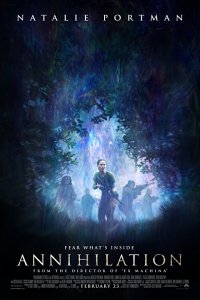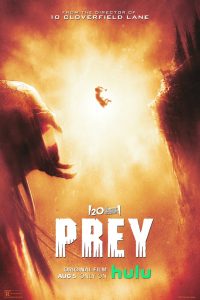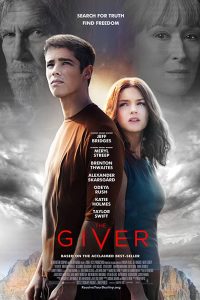Star-Crossed Horizon: A Review of Tomorrowland
 by Gary Westfahl
by Gary Westfahl
In the final analysis, Brad Bird’s Tomorrowland is a film that one yearns to love, but not a film one can actually love. In contrast to a superbly crafted piece of entertainment like Mad Max: Fury Road (review here), the film’s pacing sometimes seems awkward or hesitant, and its back story is poorly explained and not entirely logical. One wishes to argue that none of this really matters, that this film needs to be cherished and celebrated because of its resoundingly optimistic message about the future, driven home by an uplifting and emotionally powerful conclusion that constitutes by far the film’s best sequence; but sadly, the more one thinks about that message, the less resonant it seems.
Although director-writer Bird and writers Damon Lindelof and Jeff Jensen apparently wished to keep their audience baffled during the first part of the film, its developments are actually just as enjoyable if viewers understand what is going on. Long ago, at the 1889 Exposition Universelle which introduced Paris’s Eiffel Tower, a small group of visionaries, including Jules Verne, Thomas Alva Edison, and Nikola Tesla, came together to establish a secret society dedicated to achieving scientific and social progress outside the purview of a society that routinely impeded such initiatives. Gaining access to another dimension, this group constructed a wondrous city there, referred to as Tomorrowland, and launched a program to bring promising individuals, like the young Frank Walker (Thomas Robinson), into their world to assist them, using special pins with a “T” symbol to show them the way to Tomorrowland. However, disillusioned because Earth seemed to be turning its back on the future, they resolved to cut themselves off from ordinary humans and exiled an older, embittered Walker (George Clooney) back to Earth. When a bright youngster named Casey Newton (Britt Robertson) belatedly learns of Tomorrowland’s existence, she joins one of its robot recruiters, Athena (Raffey Cassidy), and Walker in a quest to get to Tomorrowland and, not incidentally, save the Earth from imminent destruction. Much of this story unfolds with an appealing, childlike charm, as Newton picks up a pin and gazes in wonder at the tall towers of Tomorrowland and later marvels at its advanced technology; but it also transpires that the denizens of Tomorrowland maintain a team of human-like killer robots on Earth, designed to spring into action and slaughter anyone who does something that displeases them. Thus, whenever they attack, Walker, Newton, and Athena must pick up some futuristic weapons and stage their own robot demolition derby. (Officially, the film’s robots are called “Audio-Animatrons” or “A.A.’s,” employing Disney’s term for the robots deployed in their theme parks.)
While one could say that Tomorrowland is engaging because of its novel and unpredictable plot, the film exists, clearly, not because it was a story that Bird felt compelled to tell, but because it presented an argument he felt compelled to convey. Decades ago, as illustrated by the exhibits at the 1964 New York World’s Fair, people looked forward to a wonderful future of gleaming white cities with soaring skyscrapers, elevated monorails, regular space travel, the peaceful use of atomic energy, and helpful scientific gadgetry. Such dreams of an attractive “retrofuture” were featured in the works of inventor and science fiction pioneer Hugo Gernsback, whose name actually comes up in the film – bizarrely, as the name employed by one of the homicidal robots; and related hopes for a future world of people from different cultures interacting harmoniously were embedded in the ride introduced at that World’s Fair, It’s a Small World, which young Walker briefly experiences. However, the film’s central image of these antiquated but appealing visions of tomorrow is the jetpack. In the opening scenes, young Walker is attempting to win a prize for inventions with his own jetpack, made out of an Electrolux vacuum cleaner, that unfortunately never really flies; when he gets to Tomorrowland, though, he is delighted when its robots repair his jetpack and enable him to soar through the air. Later, during Newton’s tour of Tomorrowland, she watches three teenagers flying with jetpacks; when one has a mishap, an ingenious device – a suit that inflates to function like an airbag – protects him from harm. And when the adult Walker engages in his final battle with Tomorrowland’s leader, Governor David Nix (Hugh Laurie), he again dons a jetpack to save the day.
Today, however, images of a future filled with happy, flying people seem outdated, the film argues, for as our news reports and popular culture relentlessly emphasize dark, catastrophic futures, people no longer believe in, or seek to achieve, a better tomorrow of scientific wonders and social harmony; indeed, instead of being inspired to avoid the apocalypse, people have embraced it – “gobbled it up like a chocolate éclair,” according to Nix. In the film, contemporary society’s relentless pessimism is actually about to cause humanity’s demise, unless dogged optimists like Walker and Newton intervene to prevent disaster and restore hopefulness to the world. And the film’s final image, after the closing credits, of a hand reaching for a Tomorrowland pin conveys the explicit hope that filmgoers will leave the theatre inspired to follow in their footsteps.
While preparing their film, Bird and his colleagues could not have known that the film would be opening one week after Mad Max: Fury Road, but Tomorrowland can readily be interpreted as a response to, and a repudiation of, George Miller’s film and others like it. How appalling!, Nix might say after watching Mad Max: Fury Road; they have taken a nightmare vision of a world devastated by nuclear war and an energy crisis and transformed it into a setting for diverting adventures! (A fictional film of this kind is advertised on the film’s billboards: ToxiCosmos 3.) Rather than recoiling from Armageddon, Nix would continue, these films demonstrate that the people of Earth have embraced it – and hence, Armageddon is precisely what they deserve. Making an analogy to the doomed Titanic, Nix even maintains that people are content to “steer to the iceberg anyway – because you want it.”
But none of this makes any sense. After watching Mad Max: Fury Road, no one leaves the theatre thinking, “Gee, I guess we don’t have to do anything to avoid running out of oil or launching a nuclear war; in fact, I hope those disasters occur as soon as possible so I can get to live in Mad Max’s wonderful world.” In other words, the mere fact that people enjoy films and video games that take place in horrible future societies doesn’t mean that they love those societies or are looking forward to inhabiting them; in fact, stark scenarios of coming catastrophes might inspire people to want to prevent them – might inspire them much more than visions of a future city with towering buildings. After all, George Orwell wrote Nineteen Eighty-Four (1949) not only because he feared a future totalitarian society, but because he hoped that his readers might be persuaded to take action to avoid that outcome; one can argue that Mad Max: Fury Road and similar films have the same, quite optimistic intent.
In decrying our society’s preoccupation with disastrous futures, Tomorrowland even seems a bit hypocritical. Consider the amount of time that the film devotes to images of its placid, idyllic Tomorrowland, and the amount of time it devotes to images of people destroying robots with ray guns, bombs, and force fields; one doesn’t need a stopwatch to figure out that the latter scenes take up more screen time. People battling for their lives in desperate situations are entertaining; people calmly embarking upon a peaceful journey into space are boring. Our purported predilection for disaster, in other words, may simply reflect our predilection for drama and conflict, the essence of all storytelling. Further, the film itself, arguably, is expressing deep pessimism about the future, as a group once led by starry-eyed idealists like Verne and Edison devolves into a group headed by a bloodthirsty tyrant, determined to kill anyone who opposes him and willing to calmly watch and do nothing while Earth is destroyed. In its own way, then, Nix’s Tomorrowland has become just as dystopian as Mad Max: Fury Road’s Citadel. One might respond that Tomorrowland does end on a very hopeful note; then again, so does Mad Max: Fury Road.
One can also criticize the notion that virtually nobody in the world is now making any effort at all to “fix the world,” except for a very few “special” people like Walker and Newton. In fact, there are innumerable individuals today who are devoting their lives to stopping nuclear proliferation, preventing global warming, avoiding famine, and alleviating poverty, and they may be distressed to watch this film and be informed that they do not exist. And although the film vehemently condemns NASA for ending its manned space flight program, it fails to note that several private companies and foreign governments remain dedicated to sending people into space, so the world is hardly abandoning this form of progress. (Amusingly, the film’s closing credits include a statement that while NASA “cooperated” with the makers of this film, they did not “endorse” its “contents.” In other words, some people at NASA were terrified that they might be chastised by Obama administration officials if they appeared to align themselves with a film that opposed one of their decisions.)
Still, despite the work that is being done, one can reasonably say that not enough people are now striving to achieve a better future; that is, the film’s concerns may be exaggerated, but they cannot be entirely dismissed. It has become commonplace to complain that contemporary science fiction has grown overly pessimistic, and while a touch of dystopia might be a necessary element in effective storytelling, an overemphasis on dystopia might be discouraging to a few people who might otherwise have chosen to address the world’s problems. Nix, who at times is allowed to seem more misguided than evil, makes a telling point when he argues that people are comfortable with a catastrophic future because “that future doesn’t ask anything of you today”; and in contrast to their hard-working ancestors who endured the Great Depression and won World War II, many modern citizens do seem less willing to take on difficult tasks, like fixing the world. Along with effort, solving the world’s problems also requires imagination, as Walker acknowledges near the end of the film: “it isn’t hard to knock down a big evil building. What’s hard is figuring out what to build in its place.” And, in an increasingly interconnected world, individuals may be finding it more and more difficult to think outside the box. In sum, maybe we do need more stories and films that would encourage people to be a bit more hopeful, a bit more energetic, a bit more creative, and even if Tomorrowland, as noted, sometimes seems to be overplaying its hand, it still might be praised as a heartening alternative to standard Hollywood fare.
Yet today, when given hundreds of millions of dollars to make profitable films, directors cannot entirely avoid the conventions of standard Hollywood fare – which explains the stark contrast between the quiet, affecting film that Bird might have wanted to make, and the flawed film that he actually ended up making. At the heart of Tomorrowland is this simple story: a group of enlightened individuals, to avoid the distractions of turbulent times, resolve to isolate themselves from the world in order to maintain and improve human society. Occasionally, they bring in new recruits to join their benevolent efforts. One virtuous individual becomes part of their world and is delighted to be in the company of like-minded people striving to achieve progress; and though he soon leaves, he later resolves to return to this enclave, eventually to serve as its leader. As it happens, this story has been told before; for shorn of a few complications, this is not only Frank Walker’s story, but also the story of James Hilton’s 1933 novel Lost Horizon and its 1937 film adaptation, directed by Frank Capra, now enshrined as a classic.
But simple stories do not get the green light today, so complications had to be introduced. It was not necessarily harmful to introduce the character of Casey Newton as Walker’s young female counterpart, though it did mean that the film effectively ended up telling the same story twice: in the prologue and in flashbacks, we see how Athena recruited Walker, and in the first hour of the film, we see how Athena recruited Newton (admittedly, in an entirely different fashion). More deleterious was the nonsensical insertion of all those killer robots. When Walker returns to Tomorrowland, Nix shakes his hand, greets him as an old friend, and treats him humanely; it is never explained why he had previously ordered his robots to murder Walker. For that matter, there is no logical motive for the robots’ attempts to track down and destroy Athena, since any individual she recruits can never get to Tomorrowland anyway or do anything that would bother its residents. And as already explained, all of this gratuitous robot violence badly undermines the film’s inspirational message. However, as reviewers observe with depressing regularity, expensive sci-fi films must include their quota of punches, pistols, and pyrotechnics, and I suppose one must admire Bird for limiting the carnage to three extended battle scenes.
As a final aside, one should also praise Bird for a scene in which he pays tribute to some of his film’s noteworthy precursors: seeking information about her Tomorrowland pin, Newton visits a Houston store, Blast from Your Past, that is filled with memorabilia from old science fiction films. Given the prominence of robots in Tomorrowland, it is not surprising to see statues of several famous film robots, including Gort from The Day the Earth Stood Still (1951), Robby the Robot from Forbidden Planet (1956), R2-D2 from the Star Wars films, and Bird’s own The Iron Giant (2004); a prominently displayed poster for the 1945 horror film Dead of Night may reference the film’s most renowned sequence, the story of a ventriloquist’s dummy that comes to life, which might be regarded as a sort of robot. But one also hears the voice of Neil Armstrong on the Moon – part of what I have argued was the ultimate spacesuit film – and one observes other Star Wars items – Stormtroopers and a frozen Han Solo; a Donald Duck toy; some piece of Planet of the Apes merchandise; and a poster for The Black Hole (1979), Disney’s first, and most disastrous, effort to make an expensive science fiction film. By having Newton place her Tomorrowland pin on that poster, Bird may have simply been inserting a plug for a film that Disney is now planning to remake, or he may have been expressing fears that his film might become another box-office disaster. It is not a fate that this much better film deserves; but in the real world, unlike the world of this film, being a visionary optimist is not always rewarding.









